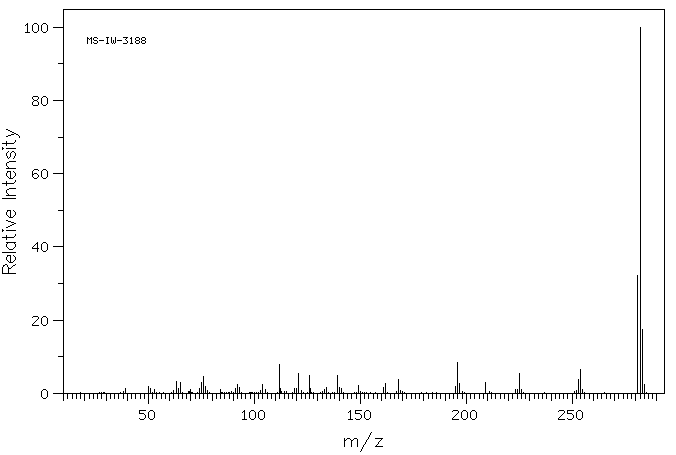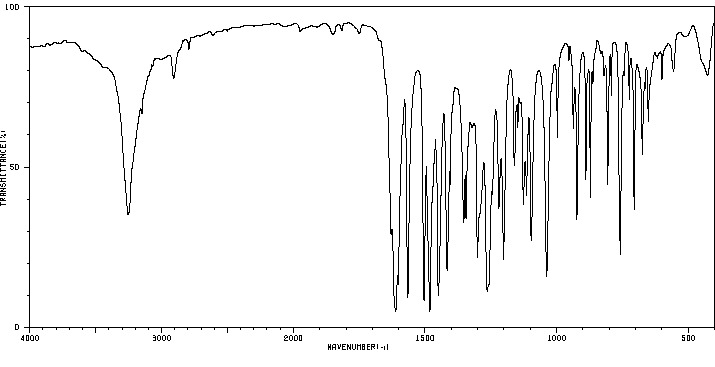2-(benzo[d][1,3]dioxol-5-yl)-3-hydroxy-4H-chromen-4-one | 19275-69-5
中文名称
——
中文别名
——
英文名称
2-(benzo[d][1,3]dioxol-5-yl)-3-hydroxy-4H-chromen-4-one
英文别名
2-(1,3-benzodioxol-5-yl)-3-hydroxy-4H-chromen-4-one;3′,4′-methylenedioxy-3-hydroxyflavone;3',4'-methylenedioxy-3-hydroxyflavone;3-Hydroxy-3',4'-methylenedioxyflavone;3-hydroxy-3,4-methylenedioxyflavone;2-benzo[1,3]dioxol-5-yl-3-hydroxy-chromen-4-one;2-(1,3-benzodioxol-5-yl)-3-hydroxychromen-4-one
CAS
19275-69-5
化学式
C16H10O5
mdl
——
分子量
282.252
InChiKey
RQYDCAXLKOYPFU-UHFFFAOYSA-N
BEILSTEIN
——
EINECS
——
-
物化性质
-
计算性质
-
ADMET
-
安全信息
-
SDS
-
制备方法与用途
-
上下游信息
-
文献信息
-
表征谱图
-
同类化合物
-
相关功能分类
-
相关结构分类
物化性质
-
熔点:214-215 °C
-
沸点:453.6±45.0 °C(Predicted)
-
密度:1.522±0.06 g/cm3(Predicted)
计算性质
-
辛醇/水分配系数(LogP):3.2
-
重原子数:21
-
可旋转键数:1
-
环数:4.0
-
sp3杂化的碳原子比例:0.06
-
拓扑面积:65
-
氢给体数:1
-
氢受体数:5
反应信息
-
作为反应物:描述:2-(benzo[d][1,3]dioxol-5-yl)-3-hydroxy-4H-chromen-4-one 以 甲醇 为溶剂, 以6%的产率得到3-benzo[1,3]dioxol-5-yl-3H-isobenzofuran-1-one参考文献:名称:Photochemistry of flavonoids. III. Photorearrangement of flavonols.摘要:在甲醇中辐照黄酮醇(1)可得到 3-芳邻苯酞(3),后者通过二酮(4)形成。金属离子(Cu2+、Ni2+、Fe3+、Co2+ 和 Be2+)抑制了这种重排。DOI:10.1248/cpb.29.894
-
作为产物:描述:2'-羟基-2-戊烯基对苯二酚 在 双氧水 、 sodium hydroxide 作用下, 以 乙醇 为溶剂, 以71%的产率得到2-(benzo[d][1,3]dioxol-5-yl)-3-hydroxy-4H-chromen-4-one参考文献:名称:SAR Studies and Biological Characterization of a Chromen-4-one Derivative as an Anti-Trypanosoma brucei Agent摘要:Chemical modulation of the flavonol 2-(benzo[d] [1,3]dioxo1-5-y1)-chromen-4-one (1), a promising anti-Trypanosomatid agent previously identified, was evaluated through a phenotypic screening approach. Herein, we have performed structure activity relationship studies around hit compound 1. The pivaloyl derivative (13) showed significant anti-T. brucei activity (EC50 = 1.1 1iM) together with a selectivity index higher than 92. The early in vitro ADME-tox properties (cytotoxicity, mitochondria] toxicity, cytochrome P450 and hERG inhibition) were determined for compound 1 and its derivatives, and these led to the identification of some liabilities. The 1,3-benzodioxole moiety in the presented compounds confers better in vivo pharmacokinetic properties than those of classical flavonols. Further studies using different delivery systems could lead to an increase of compound blood levels.DOI:10.1021/acsmedchemlett.8b00565
文献信息
-
Discovery of a Prenylated Flavonol Derivative as a Pin1 Inhibitor to Suppress Hepatocellular Carcinoma by Modulating MicroRNA Biogenesis作者:Yuanyuan Zheng、Wenchen Pu、Jiao Li、Xianyan Shen、Qiang Zhou、Xin Fan、Sheng-Yong Yang、Yamei Yu、Qiang Chen、Chun Wang、Xin Wu、Yong PengDOI:10.1002/asia.201801461日期:2019.1.4isomerase Pin1 plays a crucial role in the development of human cancers. Recently, we have disclosed that Pin1 regulates the biogenesis of miRNA, which is aberrantly expressed in HCC and promotes HCC progression, indicating the therapeutic role of Pin1 in HCC therapy. Here, 7‐(benzyloxy)‐3,5‐dihydroxy‐2‐(4‐methoxyphenyl)‐8‐(3‐methylbut‐2‐en‐1‐yl)‐4H‐chromen‐4‐one (AF‐39) was identified as a novel Pin1肽脯氨酰顺-反异构酶中Pin1在人类癌症的发展至关重要的作用。最近,我们披露了Pin1调节miRNA的生物发生,miRNA在HCC中异常表达并促进HCC进展,表明Pin1在HCC治疗中的治疗作用。在此,7-(苄氧基)-3,5-二羟基-2-(4-甲氧基苯基)-8-(3-甲基丁-2-烯-1-基)-4H-铬-4--1(AF-39)被鉴定为新型的Pin1抑制剂。生化试验表明,AF-39有效抑制中Pin1活性,其IC 50的1.008μ值米,并且还显示中肽基脯氨酰异构酶对中Pin1高选择性。此外,AF‐39以剂量和时间依赖性方式显着抑制HCC细胞的细胞增殖。从机制上讲,AF-39调节XPO5的亚细胞分布并增加HCC细胞中miRNA的生物发生。这项工作为HCC治疗提供了有希望的先导化合物,突出了基于miRNA的疗法对人类癌症的治疗潜力。
-
An Expeditious Synthesis of Flavonols Promoted by Montmorillonite KSF Clay and Assisted by Microwave Irradiation under Solvent-Free Conditions作者:Mariappan Babu、Kasi Pitchumani、Penugonda RameshDOI:10.1002/hlca.201200336日期:2013.7A simple, efficient, rapid, and ecofriendly synthesis of flavonols in >90% yield from 2′‐(mesyloxy)epoxychalcones (=2‐(3‐aryl‐2,3‐epoxypropanoyl)phenyl methanesulfonates) promoted by montmorillonite KSF clay and assisted by microwave irradiation has been described.
-
Effect of an Electron-Donating Substituent at the 3′,4′-position of 3-Hydroxyflavone: Photophysics in Bulk Solvents作者:Deborin Ghosh、Giasuddin Ahamed、Shaikh Batuta、Naznin Ara Begum、Debabrata MandalDOI:10.1021/acs.jpca.5b09681日期:2016.1.14was stabilized in relatively polar solvents, whereupon the enol → tautomer excited state intramolecular proton-transfer (ESIPT) rate decreased. Hydrogen-bonding solvents caused further retardation by interfering with the intramolecular hydrogen bond that promotes ESIPT. Among these solvents, hydrogen bond donors appear to be more efficient ESIPT inhibitors than hydrogen bond acceptors. Femtosecond fluorescence
-
LACTATE DEHYDROGENASE INHIBITOR AND ANTIEPILEPTIC DRUG CONTAINING SAME申请人:National University Corporation Okayama University公开号:EP3257510A1公开(公告)日:2017-12-20The invention provides a lactate dehydrogenase inhibitor that makes it possible to suppress refractory epilepsy in which conventional antiepileptic drugs are ineffective, and an antiepileptic drug containing said inhibitor. The lactate dehydrogenase inhibitor of the invention contains a compound represented by formula (III); i.e., isosafrole or a compound having isosafrole as a scaffold, and the antiepileptic drug of the invention has these compounds as an active ingredient.
-
Dhoubhadel, S. P.; Tuladhar, Sudersan M.; Tuladhar, Sarbajna M., Indian Journal of Chemistry - Section B Organic and Medicinal Chemistry, 1981, vol. 20, # 6, p. 511 - 512作者:Dhoubhadel, S. P.、Tuladhar, Sudersan M.、Tuladhar, Sarbajna M.、Wagley, Pradyumna P.DOI:——日期:——
表征谱图
-
氢谱1HNMR
-
质谱MS
-
碳谱13CNMR
-
红外IR
-
拉曼Raman
-
峰位数据
-
峰位匹配
-
表征信息
同类化合物
([2-(萘-2-基)-4-氧代-4H-色烯-8-基]乙酸)
龙血树脂红血树脂
鼠李素
鼠李柠檬素3-O-beta-D-鼠李三糖苷
鼠李柠檬素
鼠李亭3-O-beta-吡喃葡萄糖苷
黄酮醇-2-磺酸钠盐
黄酮胺
黄酮榕碱
黄酮地洛
黄酮哌酯
黄酮
黄诺马甙
黄苏木素
黄花夹竹桃黄酮
黄芪总皂甙
黄芩黄酮II
黄芩黄酮I
黄芩黄酮
黄芩苷甲酯
黄芩苷
黄芩素磷酸酯
黄芩素一水合物
黄芩素-7-甲醚
黄芩素 6-O-beta-D-吡喃葡萄糖苷
黄芩素
黄烷酮腙
黄烷酮-d5
黄烷酮
黄杞苷
黄宝石羽扇豆素
麗春花青苷
鳞叶甘草素B
高车前苷
高车前素-4'-O-Β-D-葡萄糖苷
高车前素
高良姜素-5-甲基醚
高良姜素-3-甲基醚
高良姜素
高圣草酚-7-O-(6''-O-乙酰基)吡喃葡萄糖苷
高圣草酚
高圣草素-7-O-Β-D-葡萄糖苷
高圣草素
骨碎补素
马里甙
马醉木素
马缨丹黄酮苷
马来酸2-乙酰基-10-[2-(二甲基氨)丙基]-10H-苯并噻嗪正离子
香风草甙
香蒲新苷








